Rattan is a common name for about 600 species of trees, mainly belonging to the genus Calamus (about 400 species) and Daemonorops (about 115 species), naturally distributed in tropical areas of Asia, Australia and Africa. Rattan is a non-timber forest product that is used as raw materials for the production of handicrafts, household items (furniture) such as tables, chairs or baskets … They are very similar to bamboo, but rattan is easy to separate. Especially bamboos are dense and do not have a hollow body like bamboo. In addition, to grow well, rattan needs human care (but it is also very easy to live in wild conditions), while bamboo may not need this. This makes it a potential tool in forest protection, as it offers a number of benefits and benefits rather than the species that must be removed.

When cut into pieces, the rattan can be used as wood for household goods. Rattan can also be painted and it has a texture like wood, so it is possible to create a variety of colors on a rattan surface and create a variety of styles. Parts of the rattan may also use household knitwear or sport ball in some Southeast Asian countries. In addition, the inner core can be separated and made into rattan.
The main raw materials are bamboo and rattan. Bamboo is used for making scorpions and rattan (rattan or roasted) to burst (tie the waistband).
Selection ensures both hardness and ductility; often choose fresh bamboo trees, biscuits. Do not choose bamboo trees that are too old because they are crunchy, do not choose young ones because they are not flexible enough; and do not choose bamboo stubs (bamboo has lost its tops from a young age), bamboo is deeply damaged, and ants are due to its fragility and weakness.

 Tiếng Việt
Tiếng Việt

